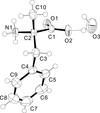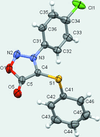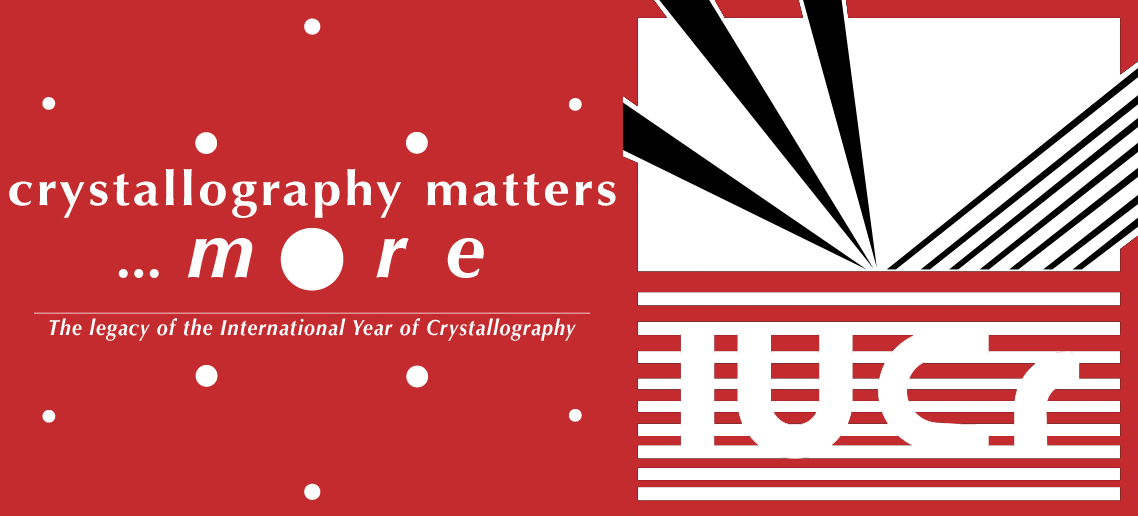issue contents
October 2016 issue

Cover illustration: In (![[eta]](/logos/entities/eta_rmgif.gif) 5-2,4- dimethylcyclopenta[b]indolyl)(
5-2,4- dimethylcyclopenta[b]indolyl)(![[eta]](/logos/entities/eta_rmgif.gif) 5-pentamethylcyclopentadienyl)zirconium(IV) dichloride, the dihedral angle between the planes of rings coordinated to Zr is 51.6 (2)°. The crystal structure features H
5-pentamethylcyclopentadienyl)zirconium(IV) dichloride, the dihedral angle between the planes of rings coordinated to Zr is 51.6 (2)°. The crystal structure features H Cl and C-H
Cl and C-H
![[pi]](/logos/entities/pi_rmgif.gif) interactions. See: Medvedev, Ryabov, Uborsky, Kononovich, Izmer & Voskoboynikov [IUCrData (2016). 1, x161408].
interactions. See: Medvedev, Ryabov, Uborsky, Kononovich, Izmer & Voskoboynikov [IUCrData (2016). 1, x161408].
metal-organic compounds
Download citation


Download citation


Open  access
access
 access
accessThe crystal structure of the novel Co/Cr heterometallic complex salt is reported. It was prepared by direct synthesis from cobalt metal and Reinecke's Salt.
CCDC reference: 1508512
Download citation


Download citation


Open  access
access
 access
accessThe crystal structure of the title complex shows a distorted trigonal–bipyramidal coordination environment of the copper(II) ion, formed by four N atoms from two pbn ligands and one Cl− ion, as well as showing intermolecular π–π stacking interactions.
CCDC reference: 1504744
Download citation


Download citation


Open  access
access
 access
accessThe crystal structure of this coordination polymer comprises helical chains constructed from ZnII ions and 2-[(dimethylamino)methyl]imidazolate ligands.
CCDC reference: 1509625
Download citation


Download citation


Open  access
access
 access
accessThe molecular and crystal structure of the centrosymmetric binuclear title complex is reported. The crystal structure features O—H⋯O, N—H⋯O, and N—H⋯N hydrogen bonds.
CCDC reference: 1508944
organic compounds
Download citation


Download citation


Open  access
access
 access
accessThe 13-membered ring system makes dihedral angles of 78.64 (9)° with the trichlorophenyl ring and 62.60 (10)° with the pyridine ring. The crystal packing is dominated by π–π interactions between the fused ring systems.
CCDC reference: 1507208
Download citation


Download citation


Open  access
access
 access
accessThe title compound crystallized with two half molecules in the asymmetric unit. The whole molecules are generated by inversion symmetry. In the crystal, molecules are linked by C—H⋯O hydrogen bonds, forming sheets parallel to (120).
CCDC reference: 1507876
Download citation


Download citation


Open  access
access
 access
accessThe structure of the title compound has a cycloheptane ring in a slightly distorted chair conformatiion with an angle of 57.13 (11)° between the five-membered ring and the benzene ring of the benzyloxy group. The crystal structure features C—H⋯O and C—H⋯π contacts.
CCDC reference: 1507508
Download citation


Download citation


Open  access
access
 access
accessThe title molecular salt is organized into a three-dimensional network structure through the 4-aminobenzenesulfonate anions and diisopropylammonium cations, linked via a series of N—H⋯O hydrogen bonds.
CCDC reference: 1507861
Download citation


Download citation


Open  access
access
 access
accessIn the chalcone derivative (E)-3-(2,3-dimethoxyphenyl)-1-(2-hydroxy-5-methoxyphenyl)prop-2-en-1-one, the dihedral angle formed by the planes of the benzene rings is 29.6 (2)° and an intramolecular O—H⋯O hydrogen bond closes an S(6) ring. Weak C—H⋯O hydrogen bonds link molecules into chains propagating along [001].
CCDC reference: 1505582
Download citation


Download citation


Open  access
access
 access
accessThe crystal structure of 5-chloroisatin 3-oxime is reported. The almost planar molecules are connected by N—H⋯O interactions into dimers, graph-set motif  (8), and by O—H⋯O interactions into chains with a C(6) motif. A two-dimensional hydrogen-bonded polymer along [100] can be assumed.
(8), and by O—H⋯O interactions into chains with a C(6) motif. A two-dimensional hydrogen-bonded polymer along [100] can be assumed.
CCDC reference: 1505940
Download citation


Download citation


Open  access
access
 access
accessThe title compound is a non-natural amino acid based on the propylbenzene group with a trans conformation, stabilized as a zwitterion interacting with a lattice water molecule.
CCDC reference: 1506760
Download citation


Download citation


Open  access
access
 access
accessThe molecular structure of the title compound, C23H31NSi2, reveals an acyclic conjugated enyne unit as the main feature.
CCDC reference: 1508008
Download citation


Download citation


Open  access
access
 access
accessTwo independent molecules, differing in the rotational orientation of the phenyl ring, comprise the asymmetric unit. π–π stacking interactions between the heterocyclic rings form stacks of molecules approximately parallel to the b axis.
CCDC reference: 1505747
Download citation


Download citation


Open  access
access
 access
accessIn the crystal, pairs of N—H⋯N hydrogen bonds link adjacent molecules, forming inversion dimers lying in the (010) plane and with  (16) ring motifs.
(16) ring motifs.
CCDC reference: 1507330
Download citation


Download citation


Open  access
access
 access
accessThe title compound contains one independent molecule in the asymmetric unit with the piperidin-4-one ring, adopting a slightly distorted chair conformation and an equatorial orientation of all the substituents except chlorine.
CCDC reference: 1508672
Download citation


Download citation


Open  access
access
 access
accessThe title compound, is an important fluorescence probe. It is composed of a 1,4,7,10-tetraoxa-13λ2-azacyclopentadecane unit linked to a twisted (Z)-2-(4-{[(E)-2-hydroxybenzylidene]amino}phenyl)-3-phenylacrylonitrile chain. In the crystal, molecules are linked by pairs of C—H⋯O hydrogen bonds, forming inversion dimers.
CCDC reference: 1413056
Download citation


Download citation


Open  access
access
 access
accessThe synthesis and crystal structure of the title molecular salt are reported.
CCDC reference: 1508896
Download citation


Download citation


Open  access
access
 access
accessIn the title compound, the dihedral angle between the planes of the two aryl rings is 7.42 (10)°. An intramolecular O—H⋯N hydrogen bond generates an S(6) ring. The crystal structure features C—H⋯O hydrogen bonds.
CCDC reference: 1508947
Download citation


Download citation


Open  access
access
 access
accessThe molecule of the title compound, which has three pyrazine rings linked by amide units, is V-shaped. Its crystal structure features N—H⋯O, N—H⋯N and C—H⋯O hydrogen bonds.
CCDC reference: 1504885
Download citation


Download citation


Open  access
access
 access
accessThe title compound is composed of an ammonium cation with a strong intermolecular negatively charge-assisted hydrogen-bonded acid/conjugate base-pair monoanion.
CCDC reference: 1508475
Download citation


Download citation


Open  access
access
 access
accessIn the crystal of the title molecular salt, C10H11N2+·ClO4−, the pyrido[1,2-a]pyrimidin-5-ium cations are linked via C—H⋯N hydrogen bonds, forming chains along [001].
CCDC reference: 1507737
Download citation


Download citation


Open  access
access
 access
accessIn this sydnone derivative, molecules are linked by C—H⋯Cl and C—H⋯S hydrogen bonds, as well as O⋯π and S⋯π interactions.
CCDC reference: 1508848
Download citation


Download citation


Open  access
access
 access
accessIn the crystal, the dodecyl side chains intercalate, forming a hydrophobic region. The bicyclic cores form a more polar region in which weak pair-wise C—H⋯N hydrogen bonds and slipped π-stacking interactions form dimers across inversion centres.
CCDC reference: 1508860
Download citation


Download citation


Open  access
access
 access
accessThe title compound contains an ion pair as well as neutral carboxylic acid and amine molecules. The components are connected by N—H⋯O, O—H⋯O and N—H⋯N hydrogen bonds, which generate  (8),
(8),  (20) and
(20) and  (24) loops.
(24) loops.
CCDC reference: 1509213
Download citation


Download citation


Open  access
access
 access
accessThe dihedral angle between the 4,6-dimethyl-pyrazolo[3,4-b]pyridine-3-one unit [maximum deviation = 0.048 (2) Å] and the phenyl ring is 5.1 (1)°. In the crystal, the organic molecules and lattice water molecules are linked via O—H⋯O, O—H⋯N and N—H⋯O hydrogen bonds. The molecules are also linked by C—H⋯π and weak offset π–π stacking interactions, forming sheets parallel to (001).
CCDC reference: 1509474
Download citation


Download citation


Open  access
access
 access
accessIn the crystal structure of the title compound, the plane of oxadiazole ring is almost coplanar with the attached pyridine ring and chromenyl ring system.
CCDC reference: 1509623
Download citation


Download citation


Open  access
access
 access
accessIn creatinium 4-methylbenzenesulfonate, the OH group of the carboxylic acid and central N atom of the cation are close to being eclipsed. In the crystal, C—H⋯·O, O—H⋯O and N—H⋯O hydrogen bonds link the components into (001) sheets.
CCDC reference: 1509564
Download citation


Download citation


Open  access
access
 access
accessThe quinoline moiety in the title compound is slightly twisted while the benzylidene and phenyl rings are markedly rotated out of the plane of the heterocyclic ring system. In the crystal, molecules are linked by N—H⋯O and C—H⋯O hydrogen bonds, forming chains propagating along [001].
CCDC reference: 1507748
Download citation


Download citation


Open  access
access
 access
accessThe pyrimidine ring is twisted with respect to the two benzene rings by 13.56 (19) and 23.1 (2)°.
CCDC reference: 1502094
Download citation


Download citation


Open  access
access
 access
accessThe title molecule is approximately planar, the dihedral angle between the naphthyl ring system and the side chain is 9.00 (14)°, and the ethoxy chain adopts an extended conformation [C—O—C—C = 176.0 (3)°].
CCDC reference: 1506733
Download citation


Download citation


Open  access
access
 access
accessThe title molecular salt, was obtained by a proton-transfer reaction between bis(trifluoromethanesulfonyl)amine and bis(dimethylamino)methane.
CCDC reference: 1510243
Download citation


Download citation


Open  access
access
 access
accessIn the title compound, the triazole ring is inclined to the coumarin ring system by 78.53 (8)°. Inversion dimers linked by pairs of O—H⋯O hydrogen bonds occur in the crystal.
CCDC reference: 1510042
Download citation


Download citation


Open  access
access
 access
accessIn the zwitterionic title compound, the pyridine ring is close to coplanar with the imidazole ring; this conformation maintained by the presence of an intramolecular O—H⋯O hydrogen bond. In the crystal, N—H⋯O and C—H⋯O hydrogen bonds link the molecules, giving a one-dimensional supramolecular structure extending along the b-axis direction.
CCDC reference: 1509954
Download citation


Download citation


Open  access
access
 access
accessThe almost planar molecule of 3H-1,2-benzodithiole-3-thione was synthesized by reacting 2,2-dithiodibenzoic acid with phosphorus pentasulfide in xylene solution. In the crystal, short S⋯S contacts and aromatic π–π stacking are observed.
CCDC reference: 1510917
Download citation


Download citation


Open  access
access
 access
accessIn this coumarin derivative, the benzoate group is oriented at a dihedral angle of 57.55 (9)° to the planar chromene ring. In the crystal, inversion-related molecules are linked into dimers via a pair of C—H⋯O hydrogen bonds, generating  (12) loops.
(12) loops.
CCDC reference: 1509735
Download citation


Download citation


Open  access
access
 access
accessIn the title bis-crown ether hydrate, one crown moiety serves as host for a guest water molecule, interacting via four hydrogen bonds.
CCDC reference: 1511205
Download citation


Download citation


Open  access
access
 access
accessThe title hydrazine compound, crystallized as a monohydrate and has an E conformation about the C=N bond. In the crystal, molecules are bridge via N—H⋯O and O—H⋯O hydrogen bonds, involving the water molecule, forming sheets parallel to the bc plane.
CCDC reference: 1511441
Download citation


Download citation


Open  access
access
 access
accessIn the title phenoxy acetic acid derivative, the pendant –OCH2COOH chain is in an extended conformation and almost lies in the plane of the benzene ring, as indicated by the dihedral angle of 2.61 (5)°. In the crystal, molecules are linked by a pair of O—H⋯O hydrogen bonds, forming classical carboxylic acid inversion dimers.
CCDC reference: 1511437
Download citation


Download citation


Open  access
access
 access
accessIn the title omeprazole derivative, the benzimidazole ring is inclined to the pyridine ring by 21.21 (8)°. In the crystal, neighbouring molecules are linked by C—H⋯O hydrogen bonds, forming chains along the a-axis direction.
CCDC reference: 1511140
Download citation


Download citation


Open  access
access
 access
accessIn the title compound, the triazole ring is planar. The plane of the triazole ring is not coplanar with the planes of the benzene rings. No classical hydrogen bonds were observed in the structure.
CCDC reference: 1511398
Download citation


Download citation


Open  access
access
 access
accessThe title benzothiazole derivative is relatively planar, with the dihedral angles between the central benzene ring and the benzothiazole (r.m.s. deviation = 0.012 Å) and pyridine rings being 3.57 (6) and 10.12 (8)°, respectively.
CCDC reference: 1509237
Download citation


Download citation


Open  access
access
 access
accessThe title benzothiazole derivative is almost planar, with the central benzene ring being inclined to the benzothiazole ring and the diethylaniline ring by 4.05 (13) and 5.05 (13)°, respectively.
CCDC reference: 1509540
Download citation


Download citation


Open  access
access
 access
accessIn the title compound, the triazole ring is inclined to the chromene ring system by 73.2 (1)°. In the crystal, molecules are linked by O—H⋯N and C—H⋯O hydrogen bonds and C—H⋯π and π–π interactions, forming a three-dimensional framework.
CCDC reference: 1509457
Download citation


Download citation


Open  access
access
 access
accessThe asymmetric unit contains two independent molecules which are linked into dimers by two intramolecular Npyrrole—H⋯Namine hydrogen bonds.
CCDC reference: 1509431
Download citation


Download citation


Open  access
access
 access
accessThe title compound is not completely planar with the dihedral angle between the benzene and side-arm being 17.4 (4)°. The key feature of the molecular packing is the formation of centrosymmetric leading to dimeric aggregates.
CCDC reference: 1411362


 journal menu
journal menu
























































![[publCIF]](/logos/authorchecklist11.gif)





